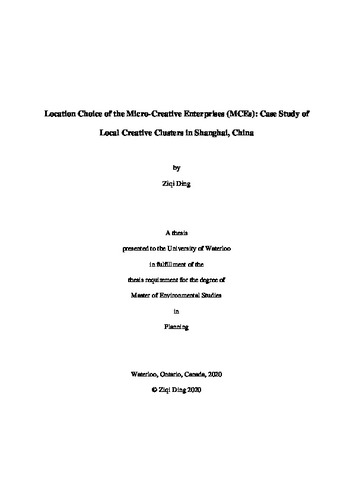| dc.description.abstract | As the creative industries have become some of the fastest-growing sectors in the post-industrial era, their location choice has been focused by both academics and policymakers. Empirical research state that creative enterprises express clustering in particular places (known as creative clusters), such as declining industrial areas, old towns and places close to universities. Micro-creative enterprises (MCEs) occupy a significant proportion of the whole creative industries, but the former’s location choice has received comparatively less attention in the existing literature. In comparison with the general creative enterprises, MCEs’ location behavior appears to be impacted by more complicated factors due to the latter’s rather small scale.
Using Shanghai as a case study, this research aims to understand the motivations of MCEs concerning their location choice as well as the weights of various location determinants at Shanghai’s neighborhood level. Notably, two local creative clusters, M50 and The Bridge 8, are selected for comparative analysis. This research employs the qualitative analysis method to analyze the data collected from the field observation, questionnaires and interviews. The researcher develops a location choice model derived from economic, institutional and creative aspects based on extensive location theories.
The results give preliminary insights into how the market, local authority and the creative class impact the development of local creative clusters respectively. Furthermore, it discusses how different development patterns have reshaped urban forms and how the perceived attributes of the places attract MCEs. The research demonstrates that MCEs’ location choice is dominantly influenced by traditional economic factors, including industrial agglomeration effects, low rent cost and geographical proximity to labor market (in this case, creative talents). Meanwhile, the institutional and creative factors are also taken into considerations by many MCEs to various extent. The results also reveal an apparent differentiation between sub-sectors of creative industries regarding their reliance on location determinants. Therefore, the location choice of MCEs cannot be explained by blanket approaches but depends on industrial characteristics, enterprise development stage and many behavioral factors. Last, key improvement strategies toward local creative clusters are discussed, including improving public engagement, cultivating creative milieu and strengthening cooperation and linkage. | en |

